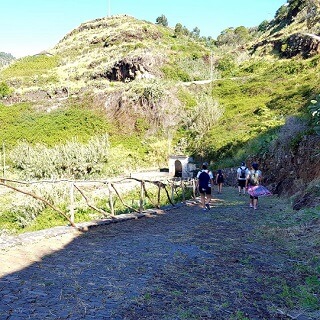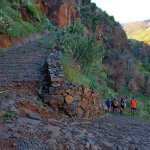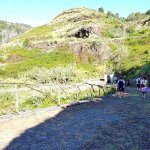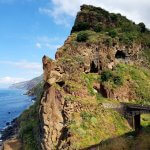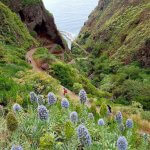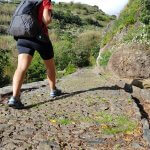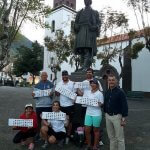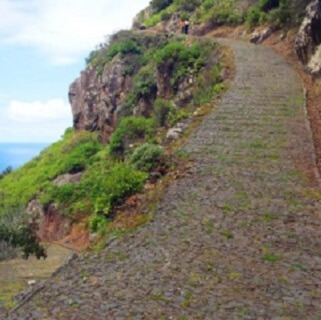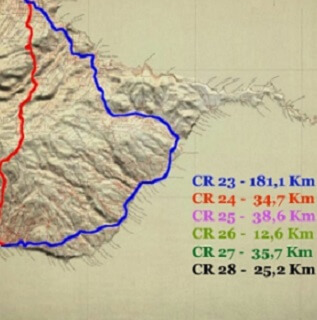
There are six royal routes crossing the Island, all of them clear evidence of the efforts necessary to overcome the barriers that make this Island simultaneously so beautiful and so difficult. The divulging and promotion of their use was the task undertaken by the Associação do Caminho Real da Madeira, made out of a group of friends that always enjoyed walking through Madeira.
The most important, especially by its integration of the territory, as well by its extension, is the first. Caminho Real nr 23 started and ended in Funchal, after more than 180 kilometres around the whole island.
The other routes are shorter – in fact, all together, they are still shorter than the first, even though they were all important, and they all went through difficult ground. Caminho Real (CR) 24 went from Santana to Funchal (Santana, Cruzinhas, Ribeiro Frio, Poiso, Terreiro da Luta and Funchal), CR 25 from São Vicente to Funchal (São Vicente, Encumeada, Jardim da Serra, Estreito and Camara de Lobos), CR 26 went from Ponta do Sol to the São Vicente valley (Ponta do Sol, Estanquinhos, and would then join CR 25), CR 27 went from Boaventura to Funchal (Boaventura, Lombo do Urzal, Boca das Trrinhas, Curral das Freiras, Eira do Serrado and Santo Antonio), while CR 28 also linked Ponta do Sol to São Vicente, but taking a diferente route.
They can all still be used, even though in some cases the original route has been taken over by more modern roads, and it is not always safe to walk along these streets – the most obvious example would be between Ribeira Brava and Serra de Água, where the need to build a sidewalk was never felt, despite the fact that this is quite a fast road.
And they all allow, now as they always did, a very close interaction between residents and travelers, feeding bonds and shortening distances. And increasing the potential returns of many small businesses, where it is possible to buy a light meal, find some lodging, or just trade a few words.
In many places there was the effort to rebuild the original path, in some – fortunately the majority of the cases, with the original material used – laminated basalt stone, placed vertically, thus allowing gains both in terms of resistance to erosion and in foot holding. There is not a constant characteristic in these paths, as they are normally wider in the places where they would be more used, and narrower in less frequented areas, namely where there was no need to cater for the need of traction animals.
A good example of these changing characteristics are the local accesses to the pier at São Jorge, a clear sign of how important this small port in the north of Madeira was for the local population.
But there are characteristics which are frequently present: there are many “casinhas de prazer” (leisure houses, small rooms next to the road which would allow people to work in their domestic chores while talking to passing people), allowing for increased contacts between residents and travelers, fountains, and load bearing points, that would allow the bearers to rest a bit before continuing their ways – these are clearly visible, still today, in points of Caminho do Monte and Caminho de Santo Antonio.
A number of members of the Associação do Caminho Real da Madeira will start, one of these days, the route around the island, something which they have done before. The goal? To enjoy the quiet, and recover serenity, avoiding cars and stress. And enjoy the landscapes and the friendliness of the island’s peoples. And show that the Caminhos Reais can be a means allowing us to get to know the history and the culture, the landscapes, the scents and the tastes of the island.
It is only a shame that, while some work to recover and keep them, and use them without damaging them, there are also those who – though lack of care or mischief, damage the Caminhos.
In the coming days there will be more of these Caminhos. Until then, good walking.
